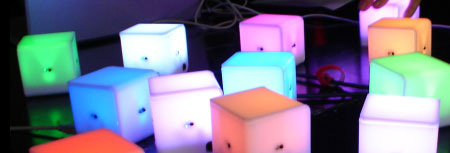
[Peter Nyboer] has written an extensive post about his experience with AudioCubes from Percussa. Aside from their unique glowing exterior, these cubes are an innovative way to control and even produce audio tracks. Four faces of each cube are equipped with IR sensors to detect distance and communicate with other cubes. The cubes also have USB, a rechargeable battery, and audio in/out. Moving your hands around the sensors changes the MIDI output of the cube. Changing the cubes’ orientation and distance from each other also changes the signal. Max/MSP and Live are both supported out of the box, but that doesn’t mean it’ll be easy to get started. [Peter] makes an important point: unlike traditional instruments, there’s no obvious way to get started. At 400euro for 2 cubes and 650euro for 4 cubes, these devices aren’t exactly being given away, but it’s great to see new interfaces being imagined. A video of [Peter]’s first experiments with the cubes is embedded below; read his full post to see more footage of the cubes in action… and naturally we’d love to see any DIY versions of this you can come up with.
















Pretty spiffy, but not a cool as the reactable.
http://www.youtube.com/watch?v=0h-RhyopUmc
http://reactable.iua.upf.edu/
Reactable is a multitouch surface with as many cubes as you can stick on it.
These cubes kinda remind me of the cube at http://h3x3n.net/ they showed it off at http://deadtech.com/ a week or two ago. It has IR leds in it, and it communicates with Wiimotes, that pass the info onto max/msp. They are releasing the source code for everything shortly.
Next step is to build these yourself. Just because these things are crazy expensive!!
Me and a friend made something similar but more selfcontained. It’s a sequencer with 6 tracks (each side of a cube) that loops, does quantization and talks MIDI to whatever software sampler/synthesizer you got. It’s built with 2 Sun SPOTs which makes it wireless.
Check it out:
http://youtube.com/watch?v=A2ovCl99Dpw
A far better way to desing those that would be more reactive and not have the annoying no trigger that even an experienced person get’s is to set up a centeral cube with 4 cheap webcams and then have specific id’s on the other cubes the webcams read.
otherwise central cube has 4 IR recievers int o4 zones. each cube has 4 Ir emitters running at 100,200,400,800hz and simply look for those tones. now change the tones for the other cubes to identify them (I.E. cube 3 has 1200,1400,1600,1800 on it… etc…)
you could build them cheaply. the center cube will be more expensive with a USB capable pic, then write the interface software.
Easy to do, and lexan is cheap.
Thanks for suggesting the DIY route — that was my first reaction when I saw these. Of course, to the creator Bart, they are a DIY project (hmm… one man’s DIY is another’s product? or something…). But I’d love to see what other directions people go along similar lines — not to clone this, but to do something different and, perhaps, better.
thats ba
Very interesting. But check out Murat Konar’s work from 5 years ago. It is strikingly similar.
http://www.muratnkonar.com/id/loopqoob/index.shtml
the concepts of tangible interfaces have been around for many years, since the 70ies if I remember from some academic publications. I believe the first such concepts were built into an installation designed by an architect. AudioCubes and Murat’s Loopqoobs are quite different ideas and systems both in concept and workings.
about the cost of the AudioCubes: each cube contains a computer (DSP) system powered by a rechargeable battery, full colour RGB LEDs and 4 sensors in and out. So, a set of cubes is a collection of small computers. If a set of 4 cubes is about 649 EUR, that means each cube is about 160 EUR. IMHO not much more expensive than other interfaces.